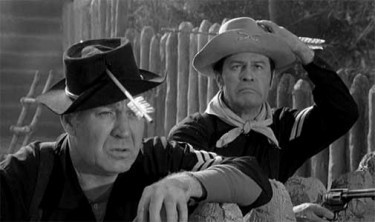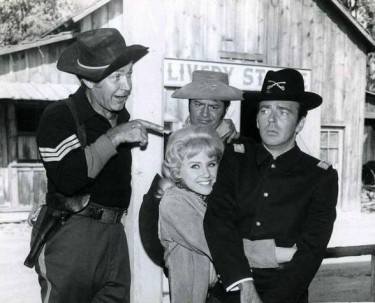The Joys And Derangement Of "F Troop"
The Joys And Derangement Of “F Troop”

Fort Courage, Kansas. Civil War hero Captain Wilton Parmenter is in command, protecting the Fort, and the neighboring town of the same name, from a tribe of Indians in the area, led by Chief Wild Eagle. With Sergeant O’Rourke and Corporal Agarn rounding out his staff, Captain Parmenter navigates Fort Courage through the dangerous waters of the expansionist latter half of the 19th Century.
Plus also: wackiness.
This is the synopsis of a situation comedy, circa 1965. Not an emphatically successful one, but “F Troop” was still a pristine specimen of what I grew up thinking was the Platonic ideal of sitcoms.
This essay is part of a series about our favorite TV shows past.
Previously: Love And Other Conspiracies Of “The X-Files”
Here’s the thing about those Gen Xers like me and the pop culture ephemera we glommed from latchkey childhoods with pre-cable VHF/UHF television sets: we weren’t so much consuming entertainment as we were soaking in it. If you were old enough to watch TV in the early 70s, a large portion of the TV you were watching, particularly after school, consisted of syndicated reruns of old network TV. There were the locally produced kids shows with cartoons as well, but after that, until prime time (and aside from the local/national news), it was reruns. “Petticoat Junction,” “The Munsters,” “Beverly Hillbillies,” “Green Acres” and even “Batman,” these were shows that had long ceased production, but lived on to fill the holes in the schedules of each local station. Accordingly, your media training — those first doses of mass media that train you how to consume and unpack entertainment — was provided by TV shows that were five or ten years dead.

So of the menu of 60s TV I was exposed to, “F Troop” is what stuck, even though I was so young at the time I can now remember only characters and vague plot outlines. (When the show was rebroadcast on Nick at Nite in the early 90s I was busy watching “The X-Files” and “The Adventures of Brisco County Jr.”) And as far as the characters went, the cast was indelible, and looking over their careers, it was a very interesting bunch. Sgt. O’Rourke was played by Forrest Tucker, a character actor and veteran of action films. He was a big man, with a foghorn of a voice, who would later co-star in the mid-70s live action Saturday morning show “The Ghost Busters” (no, not those Ghostbusters, but ghosts were busted) with Larry Storch, the irrepressible stand-up comic who played O’Rourke’s foil, who had a long voiceover career and performs Broadway and clubs in New York to this day. The romantic interest, “Wrangler” Jane Thrift, was played by Melody Patterson, who was only 16 when she was cast. (Patterson maintains an old-timey official website which may be a bit out of date but is charming nonetheless, with the obligatory 9–11 e-ribbon, and the “Wrapping with Wrangler” column.) And Capt. Parmenter was Ken Berry, a song-and-dance man who came up through talent shows and Vegas, who was later a mainstay of Disney (Herbie Rides Again and The Cat From Outer Space) and Carol Burnett. It was his dance training that accounted for the clumsiness of Parmenter, tripping, falling over things, etc. An autobiographical nugget about Berry: Back in the 50s, he had served under Sgt. Leonard Nimoy (who encouraged Berry to move to LA after his service) in the Special Services Corps of the Army, and was later mentored by the likes of Andy Griffith and Lucille Ball. Overall the cast was a tight ensemble, and by all accounts a tight bunch on the set. (Here, have some bloopers.)
Interesting, so what? Well, the thing is, since I was watching “F Troop” in reruns, I would occasionally see one of the cast members in a different context contemporaneously. We saw the Herbie film in the movie theater, and I’d see Forrest Tucker and Larry Storch (and a guy in a gorilla suit) reteam up in the aforementioned “The Ghost Busters” while eating Saturday morning pancakes off a TV tray. The question this presented my little brain: how can these TV people be different people on different shows? I mean, that’s clearly O’Rouke and Agarn on that show about the ghosts. Streams were being crossed. Which led pretty quickly to a nascent understanding of how show biz worked, and still does. And all these years later, it’s a trip to look up these actors, three of whom are still alive, and just gaze at the paths illustrated by the various resumes, leading up to “F Troop,” and then following its cancellation in 1967 (which happened somewhat mysteriously.
An even more important lesson learned was from the casting and characterization of the members of the Indian tribe, the Hekawi. I was a little kid, so I was taking as gospel the depiction of the tribe: “Me not see White Man many moons” patois, one-liners dropping like F bombs, and shrewd in the ways of business. This was of course inaccurate (and objectionable in now obvious ways). However, considering that there was not a single Native American playing a Hekawi, it had a hidden logic: the actors were New York Italian and Jewish comics, and what they were doing was standard Borscht Belt schtick. Even the given name of the tribe is a routine — tribe wanders, falls off cliff, wonders, “We lost. Where the heck are we?” This was probably pretty clear, maybe even hilarious, to the grown-ups of the mid-60s, but it took me a couple years to parse that. But again, I was unwittingly introduced to a walk through show-biz history.
As an example, take this clip, a quick little two-hander featuring Chief Wild Eagle (Frank de Kova) and (really) Crazy Cat (Don Diamond).
And the structure of this particular sitcom was what I came to find out to be called subversive. It was not so much a family sitcom (like “Leave It To Beaver” and “The Dick Van Dyke Show”), but more of a “caper” sitcom. Long story short, Sgt. O’Rourke is the true protagonist of the show, and he runs the fort and the town like a benign kingpin, pulling the strings, calling the shots. Cpl. Agarn is O’Rourke’s right-hand man, so the non-commissioned officers are running the joint, with the help of the Hekawi, who are partners-in-crime with O’Rourke, and who would on occasionally stage fake acts of aggression for the Fort to “repel” so that Cpt. Parmenter could keep his job, as Parmenter was a well-meaning yet naïve clumsy oaf from a well-heeled military family, whose relative witlessness was unlikely to uncover O’Rourke’s enterprise anytime soon. It had its precedents, in “McHale’s Navy” and some of the plots of “The Honeymooners,” but it was my first exposure to what you could call an underground economy, where nothing is as it seems and the real action is not where you can see it. Of course I didn’t realize it at the time, but it’s a pretty useful situation to be sensitive to, out here in the real grown-up world. By way of illustration, I get a more clarified smack of the same insight when reading Neal Stephenson’s The Baroque Cycle.
It was a curious habit of the time to set comedies in deliberately unfunny circumstances. Think about it: were there now a sitcom based in the times of our slow subjugation of the indigenous peoples — or better yet, in a German concentration camp circa WWII — it would be not only considered transgressive, but also make “Louie” and “It’s Always Sunny In Philadelphia” look as toothless as “The Big Bang Theory.” This subtle derangement was a gateway drug, one that led to an appreciation of popular entertainment that was a little more than straightforward. “F Troop” was a standard-issue TV product from soup to nuts, but the underlying sense of dislocation is the product of its time, and it’s what seeped into the little kid brains of the Gen Xers — at least the ones like me, parked cross-legged in front of the TV as big as a cabinet, unaware unaware of what “meta” was, or that someday “meta” would become a mild libel.
Previously in series: Love And Other Conspiracies Of “The X-Files”
